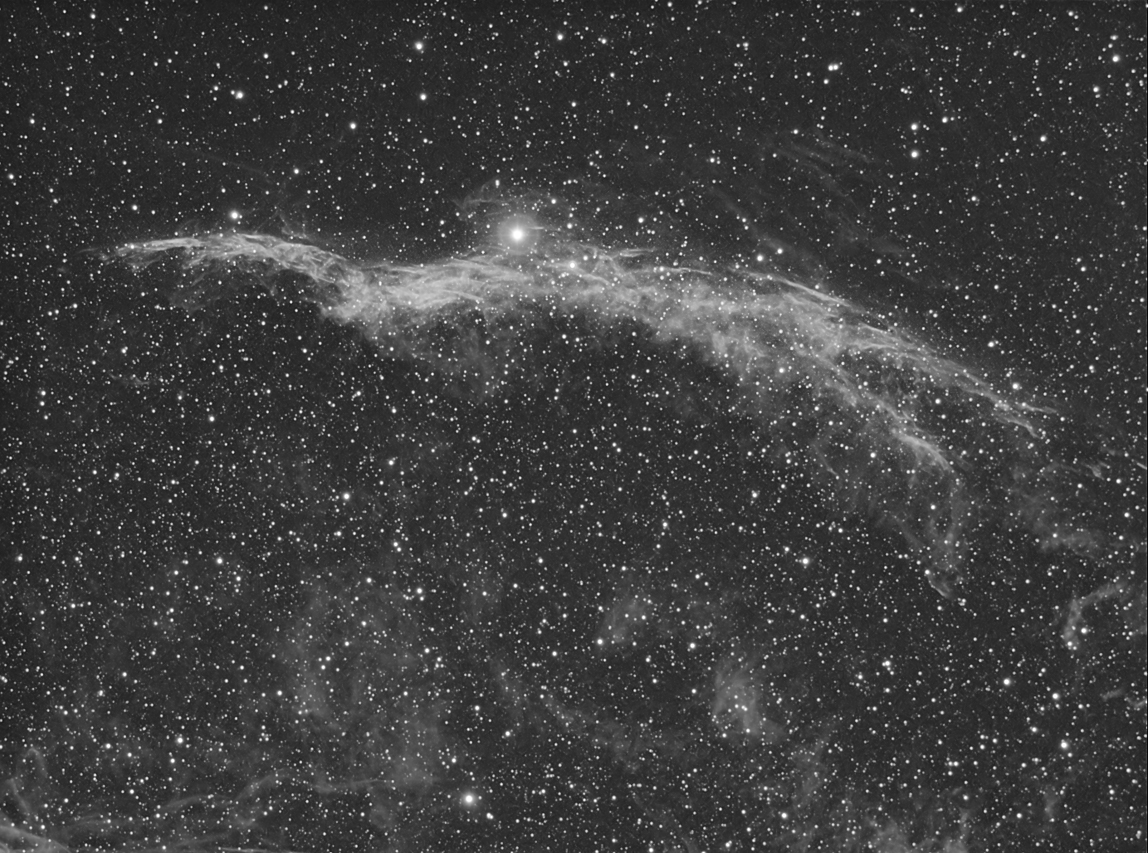The Western Veil in Hydrogen Alpha (NGC 6960)
Characteristics:
Magnitude: ? (but fainter than the Eastern Veil, which is
roughly magnitude 5.0)
Size: about 70'
Distance: 2600 light years
RA: 20h 45m 42s
Dec: 30 degrees 43' 00"
Description:
The Western Veil is a supernova remnant that is part of a larger
complex that includes the Eastern Veil
(NGC 6992) and Pickering's
Triangle (this complex is also known as the "Cygnus Loop").
In the
orientation shown above, the Western Veil is sometimes referred to as
the "Witch's Broom"
Nebula. It is estimated that the supernova explosion occured
about 10,000 years ago, before the age
of recorded history. The star that gave rise to this supernova
remnant
is no longer visible, but it must have been massive.
Supernovas represent the final stages of stars that generally contain
more than 10 solar masses. Sequential fusion of hydrogen to
helium, and subsequently to other elements like carbon, silicon, and
oxygen, eventually leads to the formation of iron in the star's
core. However, fusion of iron is energetically unfavorable and
actually requires input of energy to occur. No further fusion
will occur, iron will quickly accumulate, and once the mass of this
iron core reaches 1.4 solar masses (the Chandrasekhar limit), a
supernova will result. Since there is no longer any outward
pressure being generated by fusion, the gas surrounding the core
undergoes gravitational collapse and subsequently rebounds against the
core, forming a supernova explosion. The
elements formed within the star as a result of fusion during its
lifetime are expelled into space during supernova explosions, later to
become
part of other stars, planets, and lifeforms like ourselves.
52
Cygnus is the bright star seen in the top half, just left of the
center, and it is not
related
to the formation of the Veil. The
Western
veil is relatively rich in oxygen, which is excited by radiation from
nearby
stars, resulting in emission in the blue green spectrum (OIII).
There
is a component of red light from excited hydrogen gas as well.
The
Veil complex is a stunning view in large aperture scopes, especially
with
the use of an OIII filter.
Photographic Details:
Date: May 30, 2004
Scope: Takahashi
Sky 90 at f4.5 with field flattener/focal reducer, on the G11 Losmandy
Mount.
Autoguider: SBIG STV with
e-finder.
Camera: SXV-H9
Filter: Astronomik
Ha filter (13 nm bandpass).
Exposures: 12 x 5' each, binned
1 x 1, 60
minutes total.
Conditions: Temperature 55 degrees F; above average
transparency; above average seeing; intermittent breeze.
Post-processing: No dark, bias, or flat frames used. Auto-aligned in
MaximDL; Sigma combined using RC Sigma Reject MaximDL, followed by DDP
in ImagesPlus (IP). Subsequent
levels and curves adjustments in Photoshop CS (16 bit format).
Please
note: Graphics on this website
may not be reproduced without author permission.
Back to Hydrogen Alpha
Home

